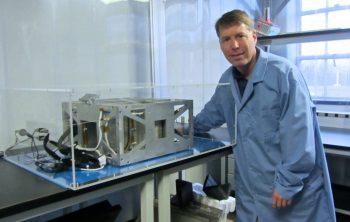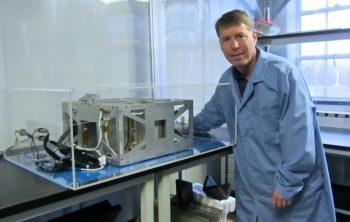
Research conducted by AE professor David Spencer is getting ready to blast off.
Literally.
As the principal investigator for the Prox-1 mission, Spencer anticipates the launch of a Georgia Tech-designed spacecraft (and an attached CubeSat) sometime within the next 18 months. Both components will be part of the multi-satellite payload launched by SpaceX Falcon Heavy rocket.
“Prox-1 will be the first spacecraft built by Georgia Tech to be launched into space,” said Spencer, who served as a mission designer for the Mars Pathfinder during nearly 2 decades with the Jet Propulsion Laboratory.
“We’ve built components before, but this is a Georgia Tech vehicle.”
Researched and tested by Spencer and his students in AE’s Space Systems Design Laboratory (SSDL), the Prox-1 spacecraft was chosen for the launch by the Air Force Office of Scientific Research’s University Nanosatellite Program (UNP) during a system integration competition last year. The SSDL design trumped a field of 11 competitors.
Spencer will join Air Force officials at Kennedy Space Center when Prox-1 hitches a ride on the Falcon Heavy rocket sometime in 2016. And his team at Georgia Tech will be overseeing mission operations when Prox-1 is deployed and the LightSail is launched. But right now, everyone’s attention is focused on fine-tuning the satellites’ components while they are on the ground.
“Prox-1 is being built here on campus. We have everything except the propulsion units and the power distribution systems, so we’re testing other things, like structure, torque rods this summer. In the fall, it’ll look more like a spacecraft.”
That spacecraft will be small -- approximately 50cm x 50cm x 30cm – and will carry an even smaller micro-satellite (“CubeSat”) called the LightSail which will be launched from, and followed by, Prox-1. Once launched, the tiny nano-satellite will itself deploy a 32-square-meter solar energy-absorbing “sail” designed to power the vehicle during its flight.
Prox-1 will re-locate LightSail and determine its orbit using infrared imaging. It will then follow the satellite from a relatively short distance --100 to 150 meters. Spencer says successful demonstration of concept on this mission will greatly benefit future space travel.
“If we can accurately control one spacecraft’s trajectory relative to another, we can do on-orbit inspections of other spacecraft. This would be great when we launch Orion. We’ll be able to use CubeSats to inspect it for micro-meteor impacts,” he said.
“And the use of passive imaging is of great interest to the Air Force Research Lab. In the past, they’ve use LIDAR and RADAR, but this will really lower the cost if we can successfully demonstrate it.”
Find out more about Prox-1 in this video.
Prof. David Spencer's work on the $1.2 million Prox-1 project has been supported, in part, by a $220,000 grant from the Air Force Office of Scientific Research through the University Nanosat Program.
